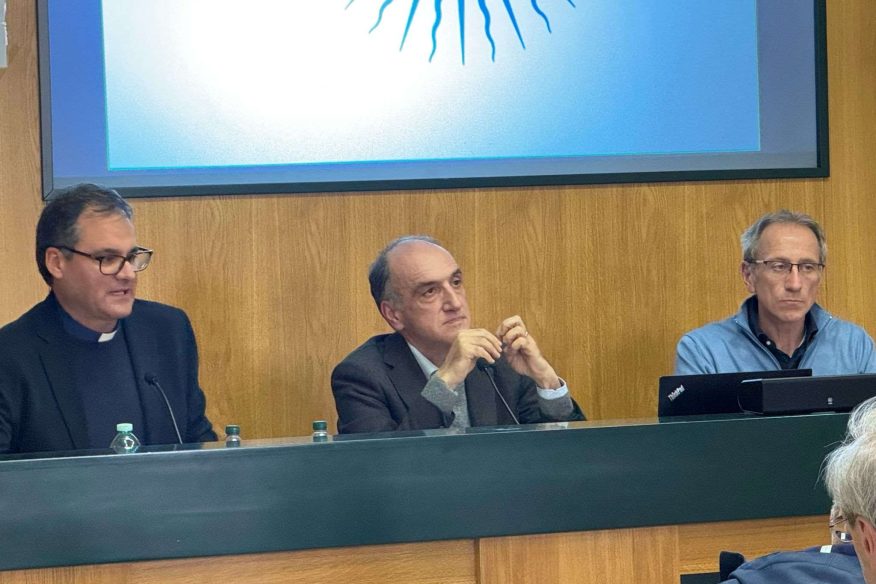What type of sacred art is relevant today? Conference in Naples in person and online

On 6 and 7 May, at the via Petrarca site in Naples, the first conference of 2022 will be held online. It is promoted by the Scuola di Alta Formazione di Arte e Teologia (Safat) of the Pontificia Facoltà dell’Italia Meridionale (PFTIM) Sezione San Luigi, in collaboration with the Fondazione Culturale San Fedele of Milan and with the patronage of the Fondazione Posillipo. Dedicated to the theme “What type of sacred art is relevant today?”, the two-day event will take an interdisciplinary approach towards this topic and art critics, artists, philosophers, liturgy experts and other experts in the field will participate.
Liturgy and imagery
Giorgio Agnisola and Andrea Dall’Asta, scientific directors of the event, explain: “The conference is intended as an opportunity to discuss the future of sacred art, in a close relationship between the liturgy and the various ways in which society interprets and elaborates on one of the central themes of contemporary life, namely the image. This is considered as a true research laboratory to continue over the years, together with the teaching staff and students, to expand further the School’s network of collaboration, and contribute to finally make the dialogue between art and church flourish again”.
On May 6, after the welcoming speeches of the co-director of Safat, Giuliana Albano, the dean of the PFTIM San Luigi Section, Mario Imperatori SJ, and the headmaster of the PFTIM, Fr Emilio Salvatore, the director of Safat, Jean Paul Hernandez SJ, will open the event with a talk on the theme “Going back to the past to develop the present”.
Creativity and spirituality
In Western culture, and in Europe in particular,” Hernandez the director highlights, “we are in a historical moment when we are probably overcoming an intellectual schizophrenia that had, in the last century and a half, separated artistic creativity from the spiritual dimension, from the deepest roots of our religious and spiritual traditions and, above all, from the demand for deeper meaning, which lies in every human heart and which leads the heart to recognise its own limits and turn to something that is much higher. This is therefore a privileged time to interpret this reunion between art and spirituality, which is not a return to the past but a rediscovery of the past with new fruition. Rediscovering this intrinsic link between art and theology, between art and mystery, has a totally new fruition compared to a thousand or five hundred years ago. The time of schizophrenia has been a time to discover this relationship: the conference aims precisely to show that art is searching for and meditating profoundly on the mystery, but it is also aiming to be of help to the more explicitly sacred spheres that are searching for new languages, a search that the Church itself finds difficult to pursue”.
Liturgical art in Italy
Coordinated by Andrea Dall’Asta sj, director of Galleria San Fedele in Milan, the session dedicated to the relationship between liturgy and aesthetics will then begin. In the afternoon, Giorgio Agnisola, coordinator of Safat’s research area, will moderate the session on the panorama of sacred art in Europe and Italy. The day will end with five working groups. On 7 May the day will begin with a session dedicated to examples of liturgical art interventions in Italy, moderated by Safat’s co- director, Giuliana Albano. Professor Andrea Dall’Asta will be in charge of the conclusions. The afternoon will be devoted to a guided tour that aims to offer an insight into contemporary art in Naples.
The School of Higher Education in Art and Theology
The School of Higher Education in Art and Theology of the Pontifical Theological Faculty of Southern Italy, St. Louis Section, has been carrying out its activities since 2006, with the aim of focusing on the relationship between art and the sacred, both in the historical-artistic and theological perspective, as well as in the perspective of communication and understanding and production of art and its proposed mechanisms and fruition. The years and the experience gained have allowed a constant evolution that led to the turning point, in 2020, with the establishment of the Diploma of Art and Theology, a unique award in Italy.
